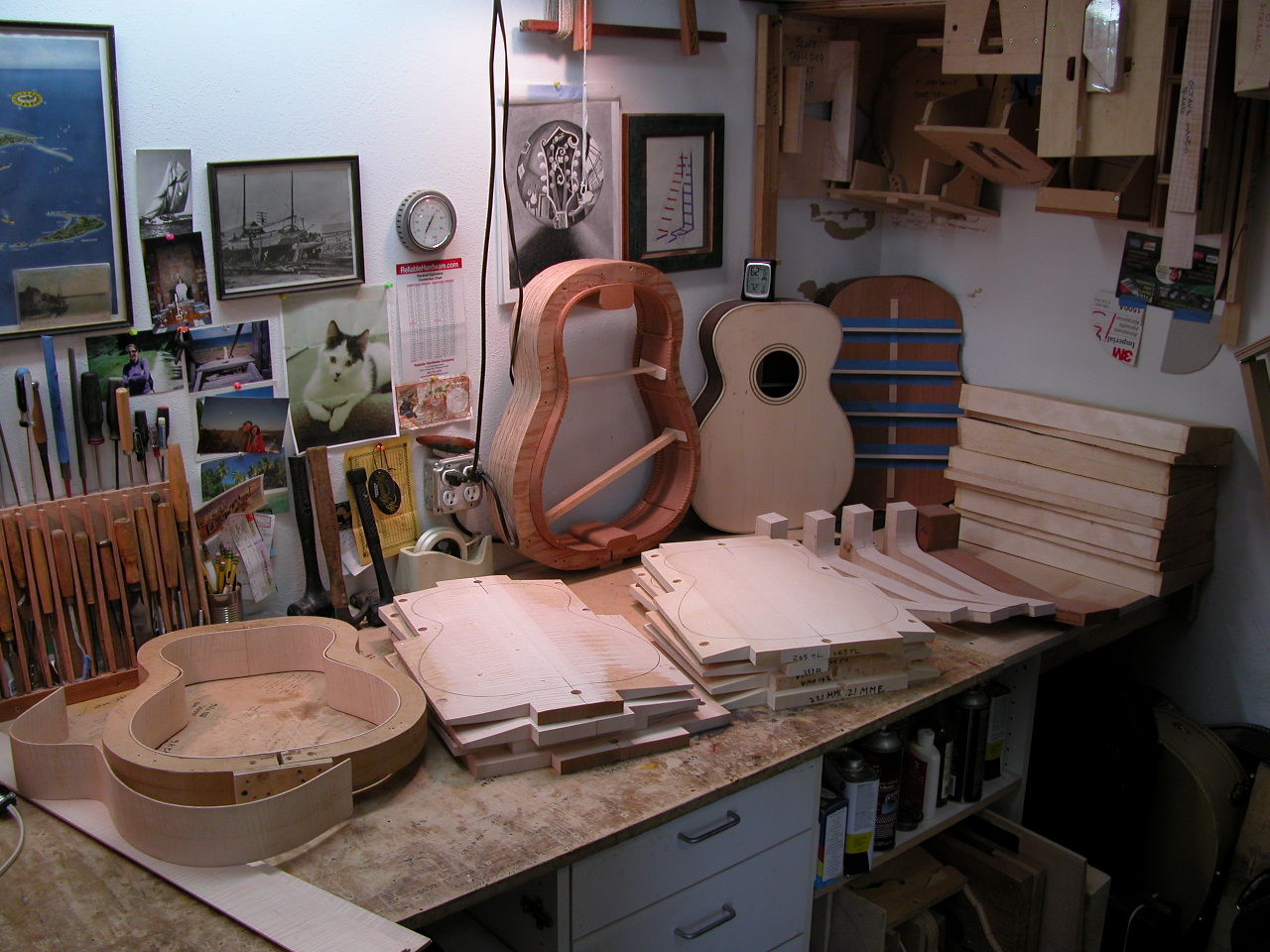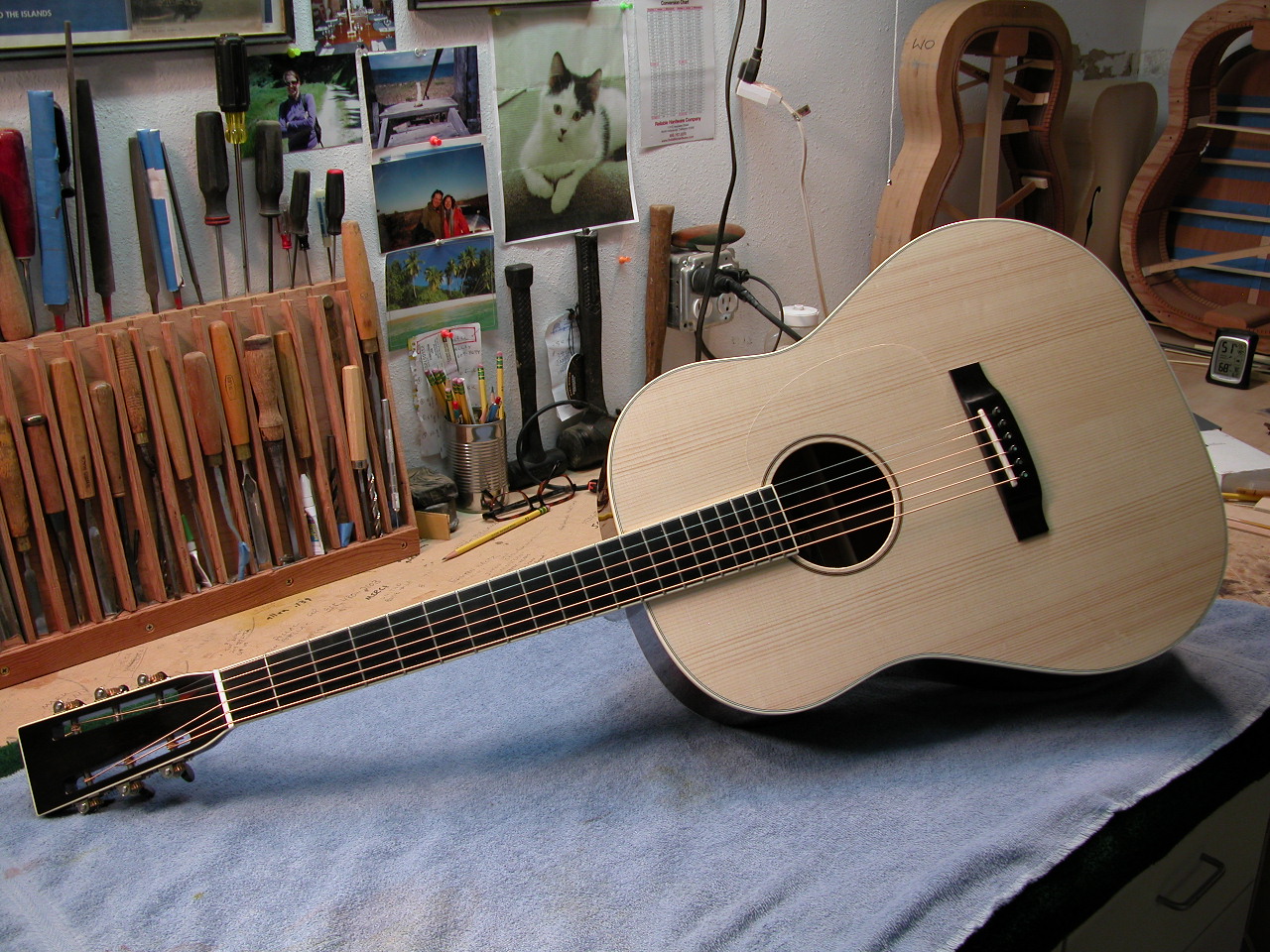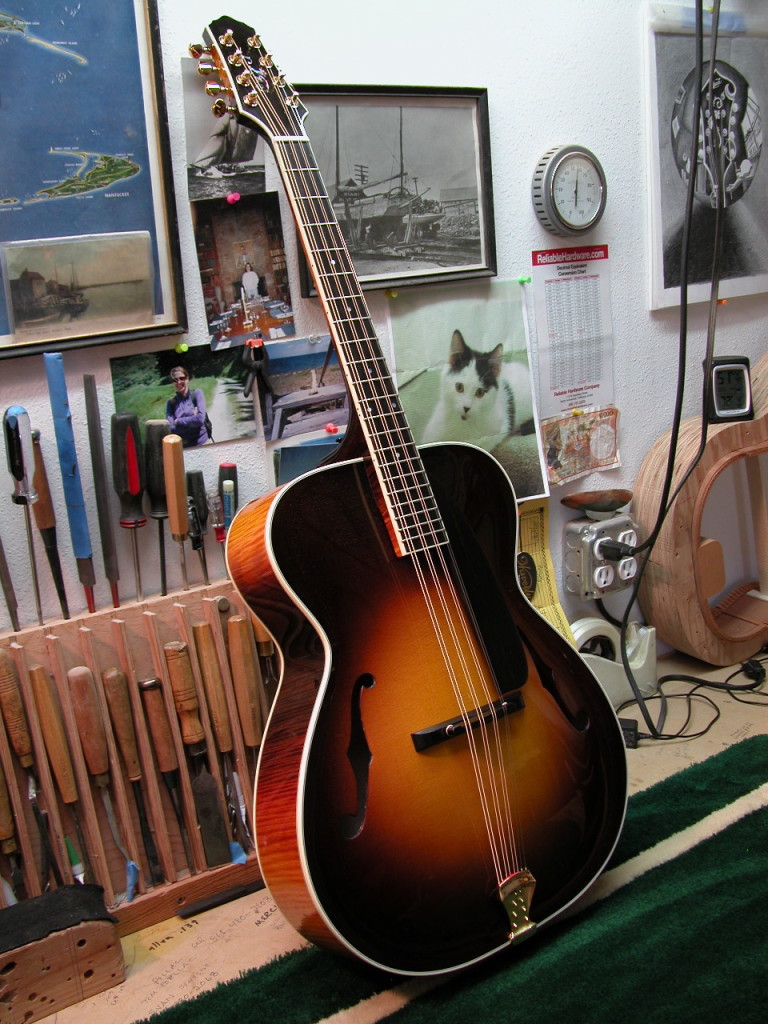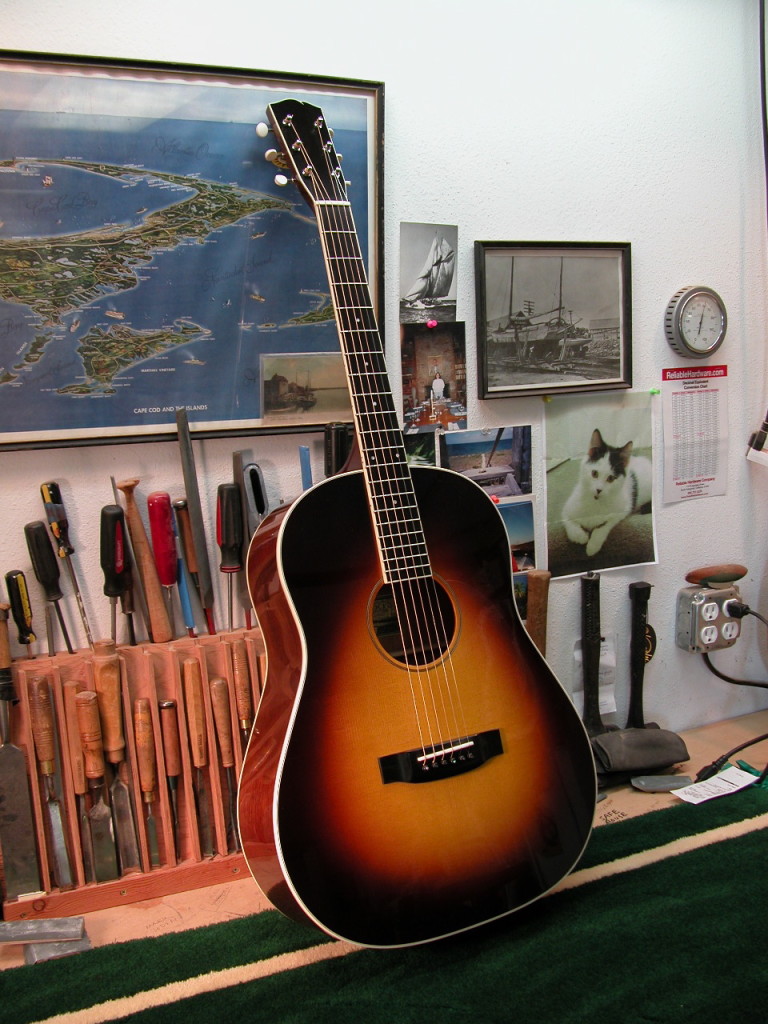Luthier Fletcher Brock must be doing something right: He’s been lucky enough to build his mandolin and guitar-family instruments in some of the most beautiful locales in America. For a long time, he built his instruments (and lived near) Seattle’s historic Jensen’s Motorboat Company boatyard. Then, as profiled by Eli West in the Fretboard Journal #32, he lived near Sun Valley, Idaho. Recently, Brock relocated to Carpinteria, a sleepy California beach community wedged between Santa Barbara and Ventura.
Over the years, Brock has built flattop guitars, mandolins, citterns and bouzoukis, but these days his work is consumed mostly with one model, the octave mandolin. In this week’s Bench Press, we talk to Brock about his move to California, the impact Sarah Jarosz has had on his orders (she can frequently be seen playing a Brock octave mandolin) and learn what a catenary arch is.

The Fretboard Journal: So what’s on the bench right now?
Fletcher Brock: I just started a new batch of octave mandolins. I’ve got four top plates glued up and four back plates glued up. Those are red maple backs from Vermont’s Battenkill Tonewoods. The tops are Canadian Engelmann from Mountain Voice Soundwoods. Those are glued up and ready for processing. I bent a set of sides yesterday and I’ve got one side that I bent this morning that’s still in the bender. I’m about to get ready to glue the end blocks and the one set of sides for the octave mandolin that I just bent yesterday. That’s what I’m working on.
I’ve got a 000 rosewood guitar, sort of Martin style, that I’m plugging away at that I’ve been working on for a while. That has Indian rosewood and an Adirondack red spruce top. I’ve got another slope-shouldered Jumbo that I’m kind of picking away at as well. But I’m sort of fast tracking the octaves because they’re the next few instruments on my order list. “Fast tracking” is relative…we’re months and months out, but that’s what I’ll be plugging at.

FJ: We filmed Sarah Jarosz playing one of your octave mandolins. Has her fame helped your business?
FB: Yeah, it has a lot. People call me up and say, “What’s that thing that Sarah Jarosz is playing? How can I get one?” Most of my business is octave mandolins these days. The mandolins just sort of slacked off a bit the past few years.
FJ: How did you get connected with her? You’re here on the West Coast and she’s on the East Coast.
FB: I’m originally from the East Coast. I moved from Massachusetts and I’m actually leaving for there tomorrow morning for a couple weeks to go back to Cape Cod. I’ve been aware of her since she was 12 or 13, when she was sitting in with people at festivals. Always had great chops and a great singer and songwriter, and she was one of the young kids jumping up on stage with all of the stars–they’d invite her up. I’ve had an awareness of her for a long time.
I went to IBMA for a bunch of years in Louisville. I think she kind of always wanted one. I had a booth at IBMA, like I had for a whole bunch of years, and I had some mandolins. She was cruising around with some friends of hers, some folks from a few other bands… I remember Kym [Warner] from the Greencards was along. They kind of passed it around and they all liked it. I don’t know if it was exactly a group decision, but it was endorsed by everybody there, and she bought it and took it. I actually gave it to Tom Ellis to take back to Austin with him and she picked it up there. She let me leave it there for the rest of the trade show.
FJ: Can you talk a little bit about that design? It’s a unique instrument. How did you come about building them?
FB: The first one that we had an awareness of was of course the one that Mike Kemnitzer [Nugget mandolins] built for Tim O’Brien quite a few years ago. That was the first one that I was aware of that had a waist in it like a guitar and Tim O’Brien did great things with that.
Then, I don’t know how many years ago, Chad Fadely, from Greg Boyd’s House of Fine Instruments, commissioned one. The way I heard the story was that Chad asked Bill Bussmann (of Old Wave Mandolins) to build one for him. Bill lives in New Mexico, and Chad is in Montana. Bill said to him, “Find someone closer.” So Chad called me up. I’d known him from festivals and from building mandolins, F-5’s mostly. I designed it so it would fit in a classic guitar case. Back then, the case thing was kind of an ongoing struggle. It has fallen in to the nightmare column a few times!
I took the scale length just by taking the Martin guitar scale’s length neck and cutting it off at the third fret, which is the G. If you fret the E string to the third fret, it’s a G, and if you use that gauge of string it sounds great on the third fret. I made the body as full as I could to get as much interior volume, X-braced it and used f-holes for projection. There was probably some influence from Dave Rawlings, too, with that cool little [Epiphone Olympic] archtop that he plays. But mostly it was probably from the Nugget and from the ones that Bill Bussmann was building. They were all pretty successful.
The first one came out really well and basically there have been no duds. I’ve never built one that didn’t sound good. That’s pretty unusual, even with tried and true designs like guitars. I mean F-5s are really hard to make sound good consistently, but this particular design just happened to hit. There aren’t any bad ones. I’ve been lucky with that. Who could ask for more?
FJ: Over the years, have you changed the design or woods in your octave mandolins?
FB: I haven’t tried any different top woods, although it’d actually be fun to try Sitka spruce sometime because Sitka has such a strong fundamental. Engelmann has beautiful overtones and really lends itself nicely to that. I’ve used Big Leaf maple for the sides and back, but more typically I use Red maple. I used to use a variety of woods for the necks, either Big Leaf maple or Red maple, but now I’m trying to use just sugar maple. It’s harder and there are eight strings on skinny little necks; I don’t really want to tempt fate.
I also have two strips of carbon fiber, pretty hefty carbon fiber, flanking an adjustable truss rod. So, they should be pretty good.
I’ve changed the arching a little bit. My first patterns were crude for the pantograph that I made. I ended up having to do a lot of the same corrections on every top that I dialed in afterwards. I finally changed my initial patterns. But that’s about it. I also talked to Mike Kemnitzer at a Wintergrass a couple years ago and he told me about a catenary arch. It’s the arch that formed when you hang a chain between two points, and it’s supposedly the strongest arch for the altitude.
FJ: So it’s like a natural curve?
FB: Yeah exactly, but there’s no cantilever to it and that’s why they specify a chain.
So I made one of those and I compared it to the arch from the neck to the tail block, and it was within fractions of being the same of what I came up with just eyeballing it, by eye and by hand. So I changed it ever, ever so slightly, like 3/64ths of an inch or something in one little section. Flattened it out, but that’s all I’ve done.
The arches on the top and the back are a teeny bit flatter than they were from the initial design, but I still have my old patterns so if I need to go back to do a run of the original, I can do that.
FJ: Let’s change gears a bit here. You’ve worked and lived in a lot of pretty cool places. Eli West profiled you in the FJ #32 when you were living in the Sun Valley area. We’ve also written in the past about your Seattle workshop that was above Anchor Jensen’s shop where he built one of the original hydroplanes? It’s probably of no interest to anybody outside of the Northwest or even Seattle, but is that right?
FB: That’s exactly correct. Actually his son, DeWitt Jensen and his wife have been staying with us down here in Carpinteria for the past five days. They just left this morning. So yeah, I was very close friends with Anchor, and my shop was in the exact spot where the Slo-mo-shun hydroplanes were built. I was kind of his right-hand man for the last years of his working life. I learned an unbelievable amount from that guy on all levels. He was definitely my mentor.
FJ: Did he build any instruments?
FB: No. I worked in his boatyard for about ten years. We still have a boat at the Jensen yard, 35-foot Laurent Giles English Cutter that my wife and I have rebuilt. Pretty much everything from the water line down is new and a lot above the water line is new. I lived on it for three years at Jensen’s. We have a really close connection with the Jensen family and have for almost 30 years from when I first started working there.
Anchor’s father was interesting in that he was a boat builder, but he was also the concertmaster of the Seattle Symphony. He spoke seven languages, he played three instruments. He was just a ridiculous polymath. Anchor was the same, Anchor’s brother was the same, Dewitt is multi-faceted and multi-talented. It’s a crazy family. They’ve got more talent than they deserve.
FJ: How did what you learn in a boatyard transfer to building instruments? Do the design elements overlap?
FB: The short answer is there are few straight lines, they’re functional art, they’re beautiful and the joinery is critical. That’s what I brought over. They’re two three-dimensional objects where every single part of it influences every other part. With all of those variables it’s the same as a boat and the joinery is wacky. There are no right angles, there are no straight line, except for maybe the neck.
FJ: Have you ever taken any boat design inspiration to your instrument building?
FB: I’ve built some funky stuff before, but I don’t have that much time for experimenting. As a matter of fact, I don’t have any time. I’ve been asked to put sound holes in the octave mandolins and I got in to it, but then I said, “No, I don’t wanna do this. I don’t have time to develop another instrument. This one is so successful.” I’ll try again someday, but right now I just have to keep moving. I’m just trying to build stuff that’s on order. I’ve got a pretty long waiting list.




